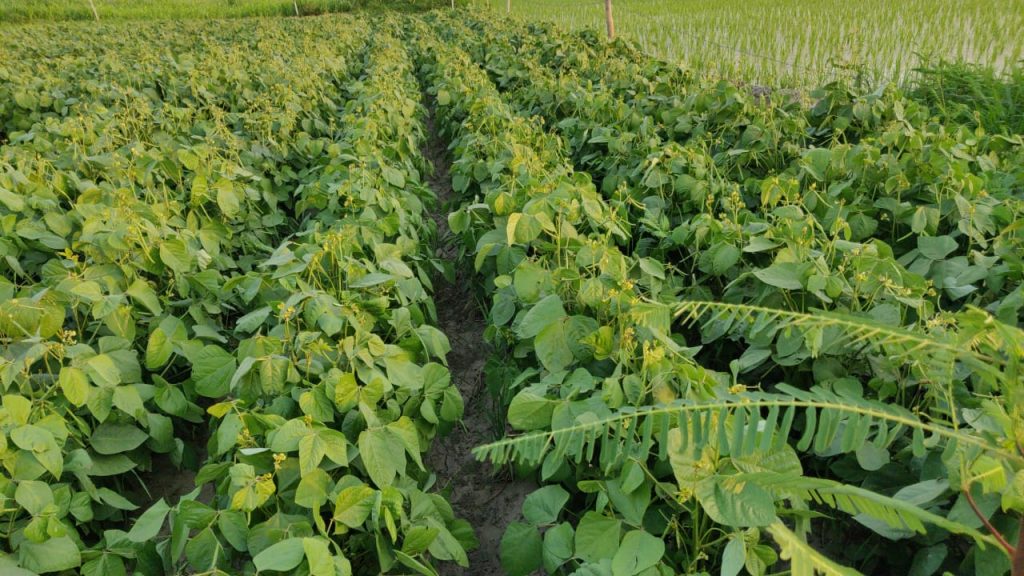Punjab farmer tries new way to cultivate moong!

A farmer from Samrala in district Ludhiana of Punjab has experimented with moong (green gram) cultivation by sowing it on raised beds. Baljinder Singh Dhillon (53) has sown summer moong variety SML 832 on 2.5 acres after harvesting wheat.
Sharing his experience, Dhillon says, “SML 832 matures in about 60 days. My crop is now 50 days old. Instead of sowing moong the conventional way of broadcasting the seeds, we have sown it on raised beds using the machine. Its major benefit to us is that it did not get damaged due to rain nor did it have any disease.”
“We did not have any major expenses on sowing the crop barring the cost of seeds and making the beds using the machine. We hope to get a good yield as it is a good variety. It should give us an average yield of 6-7 quintals per acre.”
“Even the government has announced the minimum support price of moong this time at around Rs 7,200 per quintal. We hope to get good returns by selling our crop at this rate.”
“We got the seed from the state agriculture department, which we sowed on beds as an experiment. After harvesting moong, we will cultivate paddy’s PR 126 variety, which is late-sown, in the field. We hope to take a good yield from paddy as well without putting any fertilizer and spending money on the crop as being a legume, moong helps in nitrogen fixation and will be beneficial for paddy.”
To download in Punjabi and Hindi, please click below.
As attempts are being made to find alternative methods to cultivate paddy, Parminder Singh, a farmer from Pal Majra village in Samrala sub-division of Ludhiana district in Punjab, had planted the crop on ridges over seven acres in 2020, after watching a video by Daler Singh, a former Punjab agriculture department officer who is a pioneer of this method. Enthused by the results of last year, he has decided to plant paddy through this method on 32 acres this season.
Appeal from a farmer to plant paddy on ridges!

Sharing his experience, Singh says, “Last year, I planted paddy on ridges over seven acres after watching a video by Dr Daler Singh and the results were very good. The yield of the crop was higher than the conventional puddled transplanted rice (PTR). This time I am planting paddy on ridges over 30-32 acres.”
“It is quite beneficial as there is very less consumption of water and other input costs are also less. There is less spending on sprays and the consumption of fertilizer is almost the same as for PTR. If the weedicides are sprayed in a proper way, then there are no weeds. Last year, we couldn’t spray weedicide on about 3/4th of an acre so there was emergence of some weeds. To control the weeds this time, we have applied a mix of Butachlor and 80-gram Saathi (pyrazosulfuron ethyl 10% wp) a day after the first irrigation. The results are very good as there are no weeds. We have also applied the same quantity of fertilizer as used in the conventional crop.”
“Seeing us, some other farmers including Rajinder Singh from my village, have also planted paddy on the ridges. Some other farmers have also been influenced by it. When we sowed wheat after harvesting the paddy planted on ridges last year, its results were also good. The yield of wheat in the fields that paddy planted on ridges was about 3-4 quintals per acre more than the crop that was sown in the fields that PTR. Even the yield of the paddy planted on ridges was about 2 quintals per acre more than the crop cultivated by the conventional method.”
“I appeal to all farmers of Punjab to move away from PTR method of cultivating paddy as it wastes a lot of water, hurts the soil and leads to many diseases on the crop. There is also a damaging effect on the next crop sown after harvesting paddy so all of us should either plant paddy on ridges or go for direct seeded rice (DSR) so that water of Punjab and the climate change are saved. I request all my brothers to follow this method of cultivating paddy from next time.”
To read in Punjab and Hindi, please click below.
Farmer shares his views on cultivating a new variety Punjab Basmati 7
In 2021, the Punjab Agricultural University (PAU), Ludhiana, had developed a new variety — Punjab Basmati 7. It had recommended the new variety for cultivation in basmati-growing regions of Punjab.
This variety was developed by involving strongly-scented traditional basmati variety Basmati 386 and the most popular basmati variety Pusa Basmati 1121. It possesses a strong aroma.
It has a medium height of 111 cm and matures in 101 days after transplanting. PAU had stated the average yield of Punjab Basmati 7 to be 19 quintals per acre.
So how was the experience of cultivating Punjab Basmati 7? Farmer Amarinder Singh, from village Mahlan in Ropar district of Punjab, said he had taken the seed of Punjab Basmati 7 from the Krishi Vigyan Kendra (KVK), Ropar and had cultivated the new variety in his fields.
He said the variety is in the interest of farmers as its plants are short in height. “The average height of Punjab Basmati 7 is shorter than Pusa Basmati 1121 and its average yield was in the range of 18 to 21 quintals per acre,” Singh said.
He said cooked rice of Punjab Basmati 7 was also very tasty to eat and has a nice aroma. However, he said, last year the rate of the new variety was around Rs 250 per quintal lower than Pusa Basmati 1121. “We hope that farmers may get a better price for Punjab Basmati 7 in the coming season,” he said.
To read in Punjabi and Hindi, click below.
Wheat sown on beds by progressive farmers largely unaffected by heat, strong winds
Shivcharn Singh Brar of Phulewala village in Muktsar district of Punjab had done an experiment by sowing wheat on two acres on raised beds, which withstood the affect of rising temperatures and strong winds that lashed the area in the fourth week of March 2023 and his input of seeds and fertilizers was also lower.
Shivcharn shares his experience.
Punjab farmer’s experiment with dry paddy method proves successful
Farmer Sarabjeet Singh Kadi Majra, from village Kadi Majra of Mohali district in Punjab, had cultivated paddy over 1.5 acres through the dry sowing method, which not helped him in saving water but cut down on other inputs like weedicides and fertilizers.
Sarabjeet shared his experience about paddy dry sowing method with a Punjab agriculture and farmers welfare department official Gurpreet Singh Saini.
Find out……
